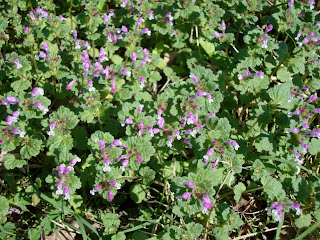In actuality, my lawn is really more of a mowed weed patch, and only part of the recent green glow is due to spring annuals, like Bedstraw, which looks innocuous now but which will easily take over the shadier parts of my yard in the next month or two. Also germinating, or sprouting from last year's roots, are hardy perennial weeds like Straggler Daisy, which, once I have pulled or mowed the taller spring weeds, will have regained control of the shady sections of my yard by summertime. But, while the Bermuda grass smartly waits a few more weeks to break its winter dormancy (if only it were so easy to kill the stuff), the real players in the sunnier parts of my yard are the winter annuals, those quiet, small weeds that germinated between the freezes and waited patiently for this, their moment of sunshine before the big weeds of spring take over.
Shepherd's Purse, a winter annual in the Mustard Family, is a reliable early season weed in my yard and it is easily recognizable by its flowering stalks holding heart-shaped fruits. (Unfortunately I pulled a patch of them yesterday before thinking to take a picture.) Henbit, a winter annual from Europe that has made itself at home in yards and disturbed areas throughout the US, also flowers in early spring, covering many lawns in east Austin with its tiny purple flowers. Up close, Henbit (Lamium amplexicaule) has the attractive, tubular flowers and upright, square stems characteristic of the Mint Family. Henbit grows close to the ground, making it a nice early-spring ground cover for those of us who aren't concerned about lawn purity, but, for serious lawn growers, I imagine that it is the first enemy of the season.
 |
| Henbit (Lamium amplexicaule) in a lawn |
The real announcement that spring is here, though, doesn't come from the weeds in the lawn but from the trees above. The American Elm (Ulmus americana) trees are always the first to bloom, usually in the first week of February. This year, with our two coldest weeks at the start of February, the elms waited until later in the month. Their tiny flowers were hardly noticeable except for the faint, green glow on the trees and the first of the spring pollen levels. After flowering, the elm trees produced loads of light green, wafer-like fruits called samaras.
 | |
| American Elm (Ulmus americana) samaras |
Once they have matured and dried, the elm samaras will carry the seeds of the tree on the wind, much as maple-tree flyers (also a type of samara) do. But for now, while the elm trees are covered in the young, green samaras of early spring, they are the most visible trees in the neighborhood, highlighted in the green glow of spring long before the surrounding trees have begun to leaf out.
 |
| American Elm (Ulmus americana) covered in samaras |
While the elm trees are lit up in green, the cherry and plum trees of the area are covered in white flowers that are sweet-smelling as well as attractive, much to the delight of many nectar-starved bees, flies, butterflies, and wasps. In the weeks right after the late-season freezes, the honeybees were so desperate for food that I was regularly finding them in my kitchen, drinking from the dish sponge, so it is a relief to see them employed again, happily buzzing from one spring blossom to another.
 |
| Cherry or plum tree (Prunus sp.) in flower |
Two native species of plums, Mexican Plum (Prunus mexicana), a small tree common along waterways, and Creek Plum (Prunus rivularis), a thicket-forming shrub, contribute to the early-spring show of white flowers in and around Austin, but in town many ornamental species of plum and cherry also bloom at the start of spring, making identification difficult. Plum and cherry trees bloom in clusters of white flowers that appear before the leaves or just as the leaves are opening. Their flowers are five-petaled, with the many stamens and the radial symmetry characteristic of Rose Family flowers.
 |
| Cherry or plum (Prunus sp.) flowers |
Texas Redbud (Cercis canandensis var. texensis) is a small, Pea Family tree that also blooms in the early spring, before its heart-shaped leaves expand. Its rose-purple flowers decorate yards, parks, and wild spaces throughout Austin from late February and to early April, attracting bees, butterflies, and moths. Texas Redbud is a drought-tolerant variety of the Eastern Redbud (Cercis canadensis) that is adapted to the limestone soils of the Edwards Plateau.
 |
| Texas Redbud (Cercis canandensis var. texensis) flowers |
The beauty of spring is in the stark contrast, of spring green in an otherwise brown landscape, or of bright white or purple against a deep blue sky. To appreciate it, I had to get out in it, to feel the warmth of the sun and to smell the plum blossoms. Then I got my shovel and gardening gloves and did some digging and weeding on the south side of my house, where the afternoon sun is concentrated. Out in it, with my hands in the soil, my sense of dread, that spring and summer and all the planting deadlines in between are looming, finally faded away. Because spring, short and fast as it is in central Texas, is a season of doing, not of worrying about the summer to come.

No comments:
Post a Comment